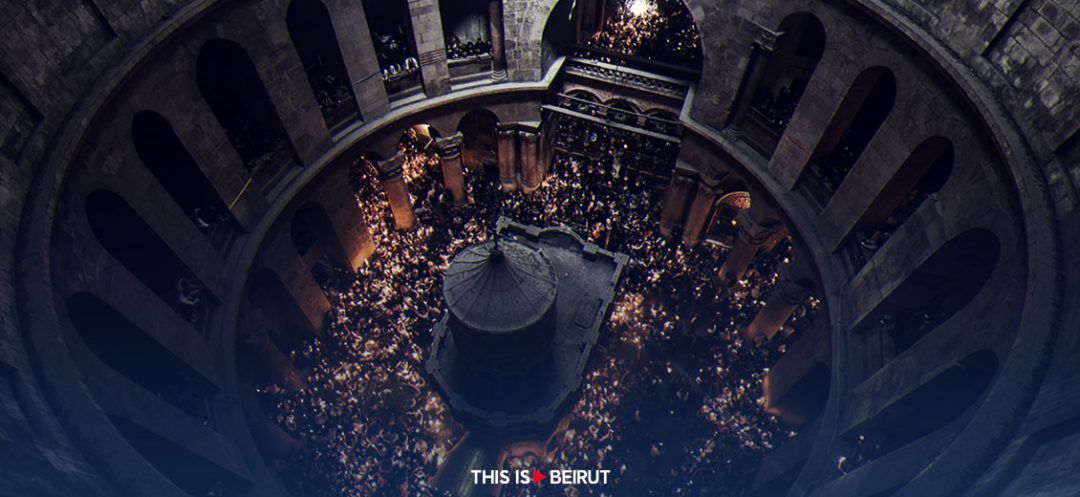
Today, on Holy Saturday, the Orthodox world will celebrate with joy the appearance of the Holy Fire, also known as the Holy Flame. This mysterious physical phenomenon is characterized by the sudden appearance of a light-density fire on the tombstone where Christ’s lifeless body was placed after his crucifixion. This fire rapidly spreads and does not burn in its initial moments.
For the Orthodox world, this flame from an unseen realm serves as a sign that undeniably authenticates Jesus's emergence from the tomb, affirming him as truly the one he claimed to be: the “Son of God.” The Nicene Council in 325 understood this title to mean “God from God, Light from Light, true God from true God,” a formulation found within the Christian Creed.
The Greek Orthodox Patriarch of Jerusalem, Theophilus III, will have the honor of entering the special structure containing the remains of Jesus' tomb and receiving the Holy Fire. He will then light the bundle of 33 candles, symbolizing the years of Christ's life, which he will hold in his hand. Afterwards, he will offer it to the crowd of pilgrims who accompanied him inside the grand basilica of the Holy Sepulcher, which encloses the chapel.
A Phenomenon Attested Since the 4th Century
Since the 4th century, the phenomenon of the Holy Fire, deemed miraculous, has stood as one of Christianity's most extensively documented events, yet it remains inexplicable. According to an auxiliary archbishop who witnessed this “miracle,” “a blue light emanates from the stone rock where Jesus' lifeless body was laid, ascending towards the marble slab covering it. This phenomenon occasionally manifests as a column comprising “a sort of fire.” The man described observing on the marble slab “a sparkling light, as if tiny pearls of white, blue, scarlet, and other colors were scattered on it.” “These pearls then melded together, glowing and transforming into fire.”
Before this solemn moment, a unique ceremonial unfolds. On Good Friday, the Israeli authorities, responsible for the site, meticulously ensure its emptiness of any flame-inducing objects before sealing it until the following day. At dawn, a multitude of pilgrims gather, ready to join in a solemn procession led by the patriarch and attended by clergy. Around noon, after shedding his sacred garments and enduring a thorough search, the Greek Orthodox patriarch (or occasionally the Armenian Orthodox patriarch) enters the tomb's dwelling, flanked by two bishops or alone, while the crowd holds its breath in anticipation.
Fifteen minutes later, the Holy Fire ignites. Amidst a chorus of jubilation, the flame is reverently passed from hand to hand among the faithful, each holding their candle aloft. According to the pilgrims, during the first moments, the Holy Fire miraculously refrains from burning either hair or faces. The Sacred Flame is then transported on specially arranged flights to multiple countries, including Lebanon.
This remarkable — and deemed miraculous — phenomenon draws thousands of pilgrims to the Church of the Holy Sepulcher each year. Despite lingering skepticism about the Holy Fire, Orthodox believers assert its authenticity as “a genuine miracle.” For some, this event serves as “convincing evidence of the truth of the Orthodox faith.” According to certain traditions, the “non-start of the Holy Fire” would indicate the imminent “end of the world.”
Field Scientific Experiments
Accusations of fraud surrounding the Holy Fire are numerous, but there is no consensus on the mechanisms involved. Physics and chemical explanations put forward are often so implausible that it seems more logical to entertain the idea of intervention from another reality into our physical world, echoing the doctrine of Saint Thomas Aquinas, who famously stated, “There is no effect without a cause.”
In the early 2000s, the Commission for Describing Miraculous Events of the Russian Orthodox Church initiated a program to study the “phenomena accompanying the descent of the fire.” Employing sophisticated instrumentation — such as an antenna, a digital converter, an oscilloscope, and a laptop for recording electromagnetic spectra — they conducted measurements during the descent of the Holy Fire. Remarkably, the analysis revealed radiation levels akin to those produced by an electric welding arc! Conclusion: this is an “authentic miracle,” achievable only through an electrical shock.”
From their standpoint, the editors of the journal Science and Religion proposed that the unique sound resonance of chants and prayers in the basilica “might trigger a piezoelectric effect, resulting in a significant electrical charge.”
The Essence Lies Elsewhere
On the archaeological level, the unveiling of the slab and the discovery of the stone purported to be Christ's resting place showcased its alignment with first-century Jewish tombs. Nonetheless, according to Marie-Armelle Beaulieu, editor-in-chief of Terre Sainte magazine, the essence lies elsewhere.
The journalist, who has lived in Jerusalem for nearly thirty years, is among the privileged few to have entered these spaces. She shares, “The Church of the Holy Sepulcher is a disconcerting site... It is not a site to be visited casually, but rather a place for prayer. Thanks to a clergyman, I was able to reach the very rock that supported Christ's body, an experience beyond my wildest dreams... I was in a strange state, almost weightless, yet every detail remains vivid in my memory. My future visits to the Holy Sepulcher won’t be the same again. Today, the marble slab has been restored over it, and the tomb is partly visible through an opening (shielded with bulletproof glass, Editor's Note). Yet, I know the stone lies beneath. I used to kneel before Christ’s tomb, reflecting on its significance, and I would contemplate the absurdity, thinking there was no Real Presence, that true genuflection belonged to the Sacred Species. However, at the Holy Sepulcher, in front of this tomb, there is the genuine absence. The presence of an absence.”
Read more



Comments